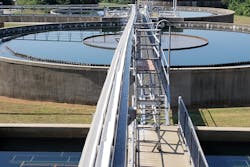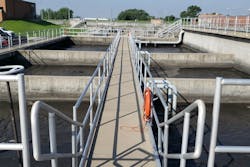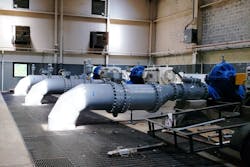About the author:
Jim Meyers is communications manager for Inductive Automation. Meyers can be reached at [email protected].
The Utility Department at the city of Fort Smith, Arkansas, provides water and wastewater services to 150,000 people within the city limits and in the greater area. The department recently replaced five disparate supervisory control and data acquisition (SCADA) systems with a single, robust software platform. This brought numerous benefits for the department, including continuity of operations across four plants (two water, two sewer), stronger security, improved reporting and uniform human-machine interface (HMI) graphics that standardize operations and training across all sites.
The new SCADA, which includes 51 remote terminal unit sites, puts all data into one seamless system. In choosing and implementing the software for the project, the utility department worked with system integrator Brown Engineers of Little Rock. The two organizations worked closely on the project for a year, completing it in late 2019.
The utility uses the Ignition software by Inductive Automation— an industrial application platform with numerous tools for building solutions in HMI, SCADA and the Industrial Internet of Things (IIoT).
“Ignition is a great product,” said Lance McAvoy, utility director for the City of Fort Smith Utility Department. “The old SCADA systems kept me up at night. This one doesn’t. And it’s helping us work smarter, not harder. Before, we had a system that worked. Now, we have a system where we can excel.”
The project had been a goal of McAvoy’s for quite some time and he is happy with the result.
“First is continuity of operations,” said McAvoy. “I can look at all the SCADA with the plants, distribution system, collection system, all from one terminal as opposed to having to go to individual locations to see each one. We have four treatment plants and two of them are located in other counties. One of them is a 45-minute drive from my office. Now we can jump on a terminal and diagnose remotely.
A Better Look & Uniform Screens
Training is much easier now, too as the utility has been afforded a means to create a uniform visual standard for screens across all the facilities.
“In the past we had multiple integrators with the SCADA software we were using,” said McAvoy. “There was no continuity in screens in what red meant, what green meant, what yellow meant. Now, everybody is on the same page. If I have to pull an operator from one plant to another, when they get over there, they’re looking at the same SCADA system. And the security is a huge factor. We have a much more secure system than we did before.”
The five legacy SCADA systems were installed at various times over a number of years. There were different versions of the software. Thus, the HMIs were not uniform, and neither were the naming conventions. And data was trapped at each facility.
Brown Engineers replaced all five legacy systems with Ignition. It cost the department two-thirds what it would have cost to upgrade the old software. The utility also gained modern technology, greater access to data, streamlined operations and scalability for future needs.
Gateway to Success
A critical aspect of the project is the Ignition Gateway Area Network, which enables the department to connect multiple gateways together, allowing many distributed features between gateways. It synchronizes data across all sites.
“They have five gateways with master/backup redundancy,” said Dee Brown, principal and co-founder of Brown Engineers. “The master/backup connections go through their IT facility at a central location. They have a troubleshooting page in case some of their wide area network goes down. And the screens have a tree view of the navigation menu, on the side.
“You just click on things and expand the list. If you’re a supervisor and you’re looking at data for one plant, and you want to pull information from another site, you just click that site and drill directly into the screens, for any of the plants and all of the distribution system. It’s one big, integrated system. It operates like it’s just one gateway. You log in one time, and you can see everything.”
Operators and managers are now seeing more data than ever before.
“We have status overview pages for the treatment plants and pump stations,” said John Guthrie, project manager for the upgrade. “I can see the information for every pump station in town. I see if there are any new alarms or any pumps we need to address, and I look over the plants to see how they’re doing.”
Improved Reporting
Previously, operators had to use third-party software for reporting. Now, the department doesn’t need that extra tool.
“Sometimes we need to create custom reports to evaluate a site’s performance during an event,” said Guthrie. “In the past, I’d have to drive to the location that has access to the data and create a new report in our third-party software. This would take at least one and a half hours to complete. Now, I can do it from my office. I’ve completed the last several requests in 30 minutes or less.”
The utility will also eliminate another software package it had been used to check status on the SCADA network at two facilities. This is another case where operators would have to drive out to the locations to get data. There’s a lot less driving now.
“We used to have to drive to all five of our main locations,” said Guthrie. “If we needed to make a change at those locations, we had to drive out there. And there was very limited data between the stations. You couldn’t see data from another treatment plant. Now, operators can call me from water, wastewater or any of the pump stations. And while I’m here in my office, I can look at it and see what’s going on and know whether I need to dispatch a mechanic, electronic or a SCADA technician.”
The department has about 35 users per day using the new software. It is used for monitoring, control, alarm notifications, tag historian, and more. Brown Engineers created screens with high-performance graphics, standardizing screens across all locations. Users can right-click on items and make changes directly, without having to go into the designer.
Brown Engineers also built a data conversion system in Ignition to import data, which was in text format from the legacy systems. The conversion tool also standardized the data and created tags for the new system. The department now has a more consistent data strategy across all sites.
Scalable Software Platform
Inductive Automaton’s Ignition software is flexible and is used in virtually every industry in more than 100 countries. A key factor in its popularity is the background of Inductive Automation’s founder and CEO, Steve Hechtman. Before starting the company in 2003, Hechtman had been a system integrator for 25 years. He was familiar with the limitations of traditional SCADA systems. Hechtman was searching for a new kind of SCADA that provided flexibility. Since there was nothing like that on the market, he and his developers created Ignition.
Ignition is a web-based platform upon which people can build a dream system. It is cross-platform and uses open standards, so it integrates well with other pieces. The unlimited licensing model means organizations pay by the server, and there are no additional costs for adding tags, devices, connections, clients, users or projects. The modular architecture allows entities to only buy the features they need, and lets them easily add more whenever they want. It installs in minutes and is easy to use. The new Perspective Module brings full control and other new capabilities to phones and tablets.
Systems Integration Teamwork
Brown Engineers did a workshop at the beginning of the process to show the department what Ignition could do.
“In the workshop, we showed the staff a lot of the features of the software,” said Brown. “That was both in terms of graphics and user defined types (UDTs) development, and the features the software has to maintain a system of this size by developing the UDTs, which save a lot of time and allow easy maintenance. And we got the staff to agree to the color schemes upfront, and from there it was much easier to keep everything with the same look and feel throughout the system. That was
really important.”
Brown also got input from the department, which was incorporated into the design.
“The workshop was very helpful,” said McAvoy. “We brought in the supervisors at the plant to get the buy-in, to show them that this actually is going to make our lives easier. Whenever you launch new software, there’s always going to be a learning curve. But it seemed like staff was much more accepting and patient because of the pre-kickoff workshop.”


